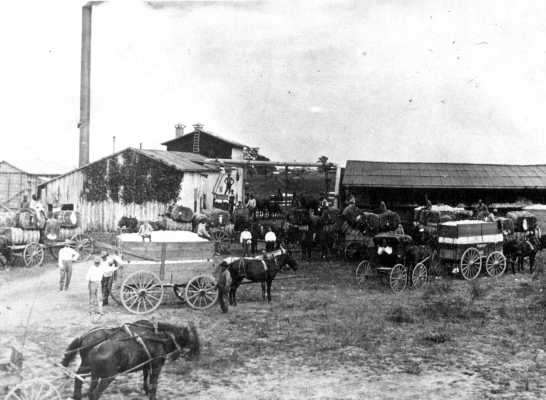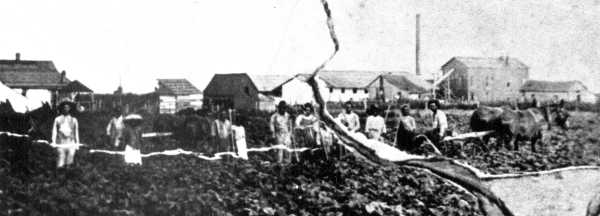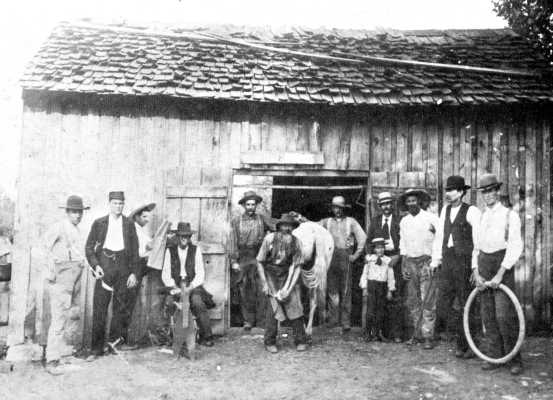yesterday's tennessee

I am enclosing a digest of the agriculture history of the upper half of the county which may throw some light on your project. Apart from Bluebank and Madie, the lower half of the county did not amount to much prior to 1870.
The history of Lake County Agriculture falls into distinct periods.
1. Bacon and Corn era, 1820-1861. The economy was geared to serving the Southern plantation system, shipping meat to the South to feed the slaves and shipping corn to the South to feed the cotton mules. (Picture A) "Meat boats" hauled great tonnage of cured bacon and shoulders down the river from Compromise and Silver Point and lesser landings around the Bend. Land holdings were not large for this kind of economy, and the largest number of slaves owned by any one person was 69, owned by Willis Jones, the father of the late Jimmy Jones of Cronanville.

Picture A
Hog killing on the W. C. "Peck" Haynes farm about 1938. Harry Wade is on the
left and Peck Haynes is in the center, (Photo courtesy of W. C. Haynes, Jr.,
Tiptonville)
2. Subsistence Era, 1861-1895. The Civil War put an end to the commercial economy of what is now Lake County. Large land holdings largely ceased to exist. For over 30 years the citizens lived largely by subsistence farming. In the north part of the county this was gradually altered by the emergence of the lien system of the country store. "Squire" Harris emerged as the large landholder north of Tiptonville, acquiring land by foreclosing on liens on crops which were offered as security for annual "furnishing." Both he and Mr. Arnett of Tiptonville pushed hard for commercial crops to secure their liens. (Picture B)

Picture B
Mules were an important part of the subsistence era scene, but they likely were
not in the good condition of this pair of grays "Bully" Smith drove in the
mid-1950's on the Peck Haynes farm in Lake County, Tennessee. (Photo courtesy
of W. C. Haynes, Jr., Tiptonvile, Tn.)
3. The Great Cotton Era, 1895-1960. Several factors changed Lake County agriculture back to commercial farming between 1890 and 1900. (A) The bollweevil sharply cut cotton production in the old Southern states at a time when demand was rising. (B) The move of the nation into a money economy made subsistence farming difficult. (C) A great warming trend in the climate which moved northward about 1890 gradually made it possible to grow cotton as far north as southern Illinois. This great warm cycle lasted until about 1960, when the climate again became more like the corn-hog era of 1820-1861, and cotton production became unpredictable. (D) Seed improvement made cotton production advantageous by 1900. But the biggest factor was the climate.
From Tiptonville north to New Madrid in 1890 there were no more than ten fields of cotton. There was one gin, a horse-powered gin at Pea Ridge (near Darnall Landing). By 1900 the county was overwhelmingly cotton. In 1900 there was a gin in Kentucky Bend, one at Bessie, one at Cates, one at Cronanville, and one at Tiptonville. (Picture C) A sharp change in population took place. In 1880 there were 18 negroes in Kentucky Bend out of a population of 303 and 23 negroes in District 1 out of a population of over 900 (imagine that!). By 1900 there were large numbers of Negroes in the Bend and in District 1 to hoe and pick the cotton. (Picture D) Meanwhile, large numbers of small farmers who did not have the resources to engage in commercial agriculture or who did not like that kind of life moved out. Many went to New Madrid and Pemiscot counties in Missouri and others to the wet lands of Bogota in Dyer County.

Picture C
Cotton gin about 1902 or 1908 owned by George R. Hopson and John B. Hopson in
Cronanville, Tennessee. (Photo courtesy of Jewel H. Hayes, Tiptonville)

Picture D
In the early 1940's cotton choppers were familiar sights in West Tennessee as
these farm hands of Peck Haynes, on the left, in Lake County. (Photo courtesy
of W. C. Haynes, Jr. of Tiptonville)
District 1 was the top area of the county until 1910. It dropped to second only with the growth of Tiptonville and the cutting away of so much high land by the river. Today it is a ghost of its former self.
I am enclosing two pictures which may be helpful: (1) A picture of Harris Parks on horseback supervising farming at Bessie in 1909. (Picture E) The picture shows part of the village of Bessie. The farm shown here was just on the north outskirts of Bessie. It was owned by my sister, Prentice Figgins, from 1935 to 1970. John Vaughn lived in the house in the left foreground and operated the "Big Store" (the Harris Store) in Bessie. (Picture F) The village was named for the Squire's daughter and was founded after 1891. The gin dominates the center of the background. For years it turned out more bales annually than any other gin in the county. Also visible are the home of Mr. Clark and the blacksmith shop over which he presided. (Picture G) At the extreme right was the Baines store. The village boasted a hotel, a postoffice, a butcher shop, the giant Harris store, a bakery and restaurant, a horse-drawn railroad from Bessie to Bessie Landing, and a drugstore.

Picture E
This is the basic picture to which Parks referred except for the absence of
Harris Parks on the horse. The unusual line is a broken spot in the picture.
(Photo courtesy of Norman Parks)

Picture F
Likely the Bessie stores were somewhat similar to Hopson's Store in Cronanville
about 1901 which George R. Hopson and John B. Hopson owned. The store had a
post office—prescriptions were filled for
medicine—groceries—and all that was needed for the community."
(Photo courtesy of Jewell H. Haynes, Tiptonvile)

Picture G
Blacksmith shop of George R. Hopson and John B. Hopson in Cronanville about
1902. (Photo courtesy of Jewell H. Haynes, Tiptonville)
(2) Cotton farming in 1925 on the J. W. Parks farm one mile north of Tiptonville. In those days every farm had to have at least one super-size mule team to do the heavy breaking in the winter and spring. (Picture H) This husky team was four years old. The plowhand in the foreground was Mack Wilson, and in the background was another plowhand, Clarence Wilson. The picture was made in late June and the cotton was already in bloom. (Pictures I & J) This was a ''good'' cotton year.

Picture H
(Photo courtesy of Norman Parks)

Picture I
About 1955 Peck Haynes posed for this picture during the first picking of his
cotton on the Lake County farm. (Photo courtesy of W. C. Haynes, Jr.,
Tiptonville)

Picture J
About 1955 field hands brought this nine foot cotton sack for weighing on the
Haynes farm. (Photo courtesy of W. C. Haynes, Jr., Tiptonville)
4. The Soybean Era, 1960 to the present. The change in the climate which makes cotton culture hazardous in Lake County at the present time, the scarcity of farm labor, the unwillingness of negroes to live in the old-fashioned shacks, and the emergence of super-power machinery all prescribe big land-holdings and extensive agriculture so well adapted to soybean production. (Picture K)

Picture K
The present day Wynnburg Cotton Gin company of Wynnburg, Tennessee. (Photo
courtesy of Mrs. Mary Algee of Tiptonville)
*Norman L. Parks of Murfreesboro, Tennessee has spent most of his life in Lake County and still owns land there.
Return to Lake County TNGenWeb
Page
Return to Contents
top · home · yesterday's · families · schools · links · what's new · memorial · about
This site was created by David Donahue and Brenda Kirk Fiddler.
This site is currently maintained by Jerry L. Butler
Copyright © 2004 - 2010, All rights reserved